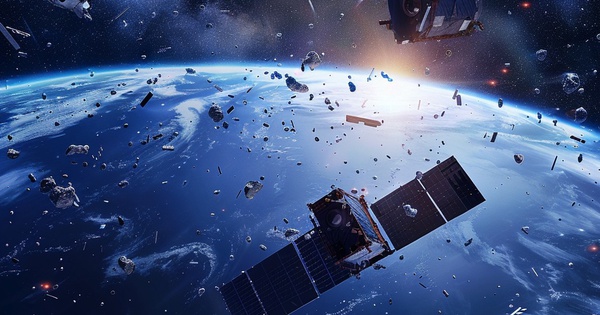Supply comes from the alien space domain, and demand from it exists.
Working at the European Space Agency, Mr. Stijn Lemmens takes on a “janitor” position like no other: Lemmens is a space waste analyst high at ESA. His job is to deal with space pollution, collaborating with spacecraft designers and other related industries. to ensure that the mission does not collide with space junk.
In the aerospace industry, launch events always attract a lot of attention, but few people pay attention to waste items into space after a flight.
Illustration of space junk.
In the past, many space missions did not take into account the consequences. Instead of calculating the flight path for expired items to be “cremated” in the Earth’s atmosphere, many satellites, boosters, etc., are left in space, suspended in orbit around the Earth. From the ground, experts must always monitor the amount of garbage nAt the same time, calculate the flight path of future missions to avoid obstacles.
“For the past 60 years, we’ve exploited space as if it’s an endless resource,” Lemmens said. “But in the last 10 years, Obviously, that’s not the case.”
At first glance, the simplest solution is to design the ships so that they become harmless after completing the mission. But the reality is much more complicated.
At ESA, Lemmens collaborates with engineers and scientists around the world, in order to find a safe solution. A few suggestions Given that a multi-use booster system could be the solution, some people seek to develop a navigation system to avoid collisions. Some other experts are looking for solutions to recover and destroy space waste without affecting the industry aviation or ground infrastructure.
“Burning” satellites and spacecraft in the atmosphere is a widely accepted method – Illustration.
After a period of interaction, the Earth’s atmosphere will pull the old satellite out of orbit. According to the official direction agreed by the countries, the satellites will lower their altitude as they gradually expire, in order to ensure that they can return atmosphere.
Previously, the goal was that this process lasted no more than 25 years; however, Lemmens and his colleagues now suggest this time should be reduced to five years or less. and manufacturing units need to take this capability into account at the beginning of the mission.
However, the process of persuading the parties to comply with the new regulations is not easy, especially when it comes to changing the general perception that the space is abundant If it is large, it can contain as much garbage as it wants. If it does not change soon, the amount of garbage flying in orbit around the Earth will soon be overloaded. obstruct future space missions and cause unnecessary accidents.
Currently, the space around the Earth contains about 11,500 satellites and more than 35,000 pieces of junk, large and small, are being monitored. Organizations, Countries are still promoting satellite launches, so the number mentioned will increase even more.
One day, we will possess technology that makes it easy to recycle satellites. But according to Lemmens, while it is not possible to do this, designers of satellites and spacecraft will have to consider long-term solutions long, creating a new standard of the industry.
Source: MIT Technology
